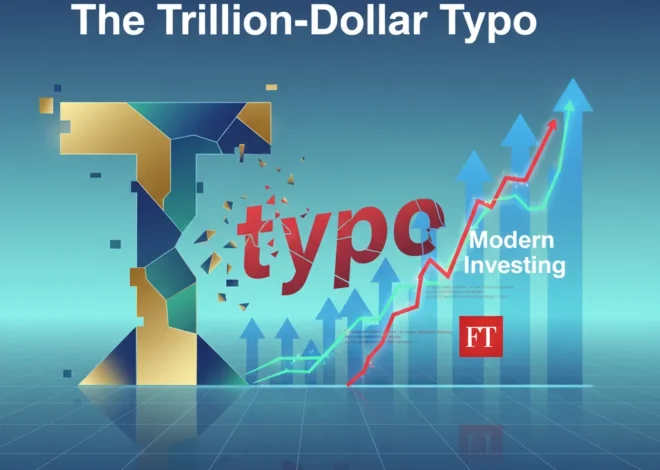
Beyond the Balance Sheet: The ROI of Mental Health First Aid in the Financial Sector
In the relentless world of finance, performance is measured in basis points, quarterly earnings, and market fluctuations. We analyze every metric, from P/E ratios in the stock market to the velocity of transactions on the blockchain. Yet, in this data-driven landscape, we often overlook the most critical asset of all: the cognitive and emotional well-being of our people. A recent letter in the Financial Times by Lisa Sharman of St John Ambulance served as a poignant reminder of this gap, advocating for mental health first aid in the workplace. While the message is universal, its implications for the high-stakes, high-stress environments of finance, investing, and banking are particularly profound.
The traditional view of corporate wellness as a “soft” perk is not just outdated; it’s a costly miscalculation. In an industry where split-second decisions can mean the difference between profit and loss, mental agility, resilience, and clarity are non-negotiable. Ignoring the psychological health of your team is akin to ignoring market risk—a liability that will eventually come due. This article explores why integrating a robust mental health strategy, specifically the concept of Mental Health First Aid (MHFA), is no longer just a matter of corporate responsibility, but a critical component of financial risk management, sustainable growth, and long-term profitability.
The Hidden Costs on Your P&L: Quantifying the Economic Drain of Burnout
For decades, the financial sector has cultivated a culture of resilience through pressure. The long hours, the demand for perfection, and the constant market volatility were seen as a crucible that forged elite professionals. However, data increasingly reveals the diminishing returns of this approach. The World Health Organization estimates that depression and anxiety cost the global economy US$ 1 trillion each year in lost productivity.
This isn’t an abstract global figure; it’s a direct hit to individual companies. The costs manifest in several ways:
- Absenteeism: Employees taking time off due to stress, burnout, or other mental health challenges.
- Presenteeism: A more insidious cost where employees are physically present but cognitively impaired, leading to reduced productivity, increased errors in trading or analysis, and poor decision-making.
- Employee Turnover: The cost of recruiting, hiring, and training replacements for top talent who leave due to a toxic or unsupportive work environment is staggering. A Gallup report suggests the cost of replacing an individual employee can range from one-half to two times the employee’s annual salary.
For investors and business leaders, these are not HR issues; they are material financial risks. A firm with a high rate of burnout is a firm with a compromised ability to innovate, adapt, and execute. It signals a systemic weakness that balance sheets alone cannot reveal.
Grounded Ambitions: Why UK Aviation Taxes Could Stall Economic Takeoff
From Liability to Asset: The Strategic Framework of Mental Health First Aid
The solution is not to eliminate pressure—a core component of the financial industry—but to equip employees with the tools to manage it effectively. This is where the concept of Mental Health First Aid (MHFA), as highlighted in the St John Ambulance letter, becomes a strategic imperative. MHFA is the mental health equivalent of physical first aid. It doesn’t train employees to be therapists; it trains them to identify the signs of mental distress in their colleagues, offer initial support, and guide them toward professional help.
Implementing such a program transforms mental health from a reactive problem into a proactive strategy. It builds a culture of “psychological safety,” a shared belief that team members can take interpersonal risks without fear of negative consequences. In the world of fintech and financial technology, where innovation is paramount, psychological safety is the bedrock of creativity. It’s what allows a junior analyst to challenge a senior trader’s assumption or a developer to experiment with a new, potentially disruptive idea.
To better understand the shift from a reactive to a proactive approach, consider the common signs of workplace stress and the corresponding MHFA-driven strategies.
| Common Signs of Workplace Distress | Proactive & Supportive Interventions |
|---|---|
| Increased irritability and uncharacteristic errors in reports or trades. | A trained colleague privately asks, “I’ve noticed you seem more stressed lately. Is everything okay?” |
| Social withdrawal and missing team meetings or social events. | A manager proactively checks in, offering flexible work options or a temporary reduction in workload. |
| Visible signs of fatigue and working excessively long hours without a drop in backlog. | Leadership promotes and models healthy work-life boundaries, discouraging a culture of “always-on.” |
| Expressing feelings of being overwhelmed or cynical about work. | Guiding the individual toward confidential company resources like Employee Assistance Programs (EAPs). |
Building a Resilient Portfolio: Actionable Steps for Implementation
Integrating a culture of mental wellness is not about adding a yoga room; it’s about fundamentally re-engineering the support systems within an organization. For leaders in banking, asset management, and other financial services, the path forward involves a multi-pronged approach.
1. Champion from the Top Down
Change must be visibly championed by senior leadership. When a managing director openly discusses the importance of mental health or shares their own strategies for managing stress, it sends a powerful signal that shatters long-held stigmas. This leadership commitment must be backed by a genuine allocation of resources—time, budget, and strategic focus.
2. Invest in Widespread Training
Implement programs like Mental Health First Aid across all levels of the organization. A 2022 Deloitte report found that for every £1 spent by UK employers on mental health support, they get an average of £5.30 back in returns from reduced absenteeism, presenteeism, and staff turnover. This isn’t an expense; it’s one of the highest-yield investments a company can make. The goal is to create a network of support, ensuring that no matter where an employee sits in the hierarchy, they are close to someone who can offer a compassionate ear and a bridge to professional help.
High Stakes at the High Court: The Trillion-Dollar Question of Presidential Tariff Power
3. Integrate Wellness into a Performance Culture
The most effective strategies do not treat wellness as separate from performance. Instead, they integrate it. This means managers are trained to have supportive conversations as part of their regular check-ins. It means rewarding teamwork and collaboration, not just individual “heroics” that lead to burnout. It involves designing workflows and using financial technology to reduce cognitive overload and unnecessary friction, rather than to simply increase monitoring and pressure.
The Macro-Economic Case: A Healthy Workforce is a Productive Economy
Zooming out from the individual firm, the principles of workplace mental health have significant implications for the entire field of economics. A nation’s productivity, innovation capacity, and economic resilience are directly tied to the well-being of its workforce. A burned-out population is less likely to start new businesses, create disruptive technologies, or make the long-term investments that fuel sustainable growth.
Periods of economic instability, such as a recession or a volatile stock market, exacerbate mental health challenges. A workforce equipped with greater psychological resilience is better able to navigate these shocks, adapt to change, and drive recovery. Therefore, by investing in the mental capital of their employees, financial leaders are not only fortifying their own companies but also contributing to the stability and dynamism of the broader economic system they operate within.
Ultimately, the conversation must shift. Mental health is not a fringe issue or a matter of personal weakness. It is a fundamental component of cognitive performance, risk management, and financial success. The numbers on the screen are driven by the people watching them. By investing in their well-being, we are making the most strategic investment of all—an investment in the engine of the entire financial industry.


